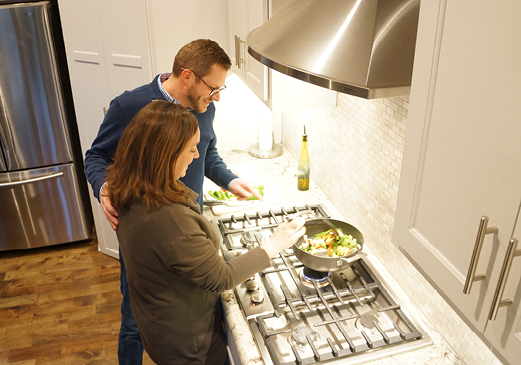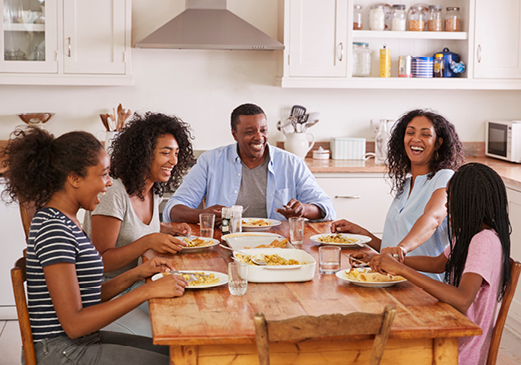Benefits of Cooking with Propane & How to Do it Well
Quick to heat with consistent, easy-to-control temperatures — that’s what you can expect with a propane-powered cooking appliance.
Propane ranges, stoves, outdoor grills, and cooktops are great at delivering the consistent heat and temperature controls needed to prepare dishes that require a delicate touch. In fact, an overwhelming 96% of professional chefs rely on open flames from fuels like propane to run their restaurants for this very reason.
In addition to propane’s superior results in the kitchen or on the grill, its energy-dense nature makes it a more cost-effective option than electric appliances. Each gallon of propane can produce the equivalent of 27 kilowatt hours of electricity. Over the life of your appliance, a propane stove costs less than electric - both in terms of daily operation and long-term maintenance expenses.
You don’t have to be a pro in the kitchen or on the grill to recognize the immediate advantage propane gives you when cooking. Let’s take a look at some of the positives.

Can you use propane with gas ranges?
A variety of propane gas ranges are available on the market today. If you have a natural gas appliance, it can be converted to use propane. The process is quite simple, and a conversion kit can be purchased online or at most hardware stores. We recommend contacting the manufacturer of your appliance first to confirm your make and model are convertible. You should also consult or hire a professional to make sure the conversion kit is installed correctly.
Cooking safe with propane
Cooking with propane is quick, easy, and efficient, but if you’re new to a propane range, we have a few tips to make your experience go as smoothly as possible:
-
Keep an eye on the flame.
Have you ever looked at the color of your burner’s flame? Next time you’re at the stove, carefully take a peek under the pan. The flame on your range should be burning blue, but if it appears yellow or orange, it’s time to call someone in for maintenance. -
Keep your burner flame low.
When it comes to flame size, low and steady wins the race. The cookware we use today is extremely conductive and holds heat well, so we don’t need as much flame to cook with as we may think. The higher the flame, the more propane is wasted. Plus, you run the risk of burning your food. -
Keep burner size in mind.
If you’re wondering how low to keep your flame, just think of the size of the cookware you’re using; the flame should be the same size as the bottom of the pan or smaller. Using a high flame with a small pot won’t necessarily cook your food faster, but it will increase the risk of burns and waste a decent amount of energy in the process.

Switching from electric appliances in the kitchen to propane appliances
Making the switch from electric to propane appliances can save you operating expenses while offering consistent heat and optimal control. The switch is relatively simple but will require a few accommodations to make it work for a previously electric household:
Purchase a propane-compatible stove and cooktop.
Some gas ranges can be converted for propane use, but an electric appliance cannot. To help offset the cost of switching to propane-powered appliances, rebates are available through various state, regional, and local governments.
Install or extend your propane supply.
If your home is already equipped with propane, getting your new propane appliance up and running will simply require running a line to your stove. If you’re new to propane, Ferrellgas can help you get started.
Note: Always use a licensed professional for any work involving flammable gases.
Prioritize ventilation.
Using an open flame stove and cooktop will require ventilation, such as a range hood, to draw fumes, steam, and smoke out of the kitchen and prevent carbon monoxide buildup. If a range hood isn’t an option, simply open a nearby door or window. If you’re unsure whether you’re providing enough ventilation to your kitchen, reach out to a professional installer for guidance.
Cooking with propane: Propane grill
Fussing with bags of charcoal and cans of lighter fluid is a thing of the past when you make the switch to a propane-powered grill. Not only is getting your cookout started as simple as turning a dial and pushing a button, but you can also count on propane to provide consistent heat for a well-cooked meal. If you’re new to propane grilling, we’ve got a few tips and tricks to help you achieve grill master status in no time.
How to manage the heat on a propane grill
One of the best features of a propane grill is its ability to heat up quickly and efficiently. However, there are a few tips and tricks to keep in mind the next time you’re manning the grill.
Preheat the grill.
Preheated grills are the key to those tasty sear marks and juicy foods we know and love. Your grill should only need 10 to 15 minutes to get ready, depending on the time of year. Rushing to put food on a grill before it’s had a chance to heat up can lead to food that is cooked unevenly or that sticks to the grill.
Use the correct heat setting.
After the grill has had time to preheat, you’ll want to adjust the burners as needed for your recipe. Each grill is different, and a grill surface thermometer may come in handy.
Pay attention to the position of your food.
Some foods require direct or indirect heat to cook properly. Indirect heat provides a low and slow heating method, similar to an oven. Direct heat is typically faster and is ideal for searing and crisping.
What is the proper temperature for grilled meats?
When it comes to cooking meat on the stove, in the oven, or on the grill, you’ll need to check the internal temperature before digging in. To ensure you’re consuming food that has been cooked to the proper temperature, we recommend following the guide below.
|
Types of Meat |
Recommended Minimum Temperature |
|
Fish |
145°F/62.778°C |
|
Ground meats |
160°F/71.111°C |
|
Poultry |
165°F/73.889°C |
|
Rare beef |
125°F/48.889°C to 130°F/54.444°C |
|
Medium-rare beef |
135°F/54.444°C to 135°F/57.222°C |
|
Medium beef |
145°F/57.222°C to 145°F/62.778°C |
|
Medium-well beef |
155°F/62.778°C to 155°F/68.333°C |
|
Well-done beef |
165°F/68.333°C |
Source: FDA/AmazingRibs.com
What device is used to measure the temperature of meats?
Meat thermometers can be a convenient, accurate method of measuring the temperature of the meats you’re cooking. These thermometers come in all shapes and sizes. From wireless and digital to leave-in and analog, the best meat thermometer you can use is the one you’ll feel comfortable reaching for every time you cook.
How to keep your propane grill clean and in good condition
Grill maintenance doesn’t have to be complicated. In fact, all you need to do is store the grill in a safe space and clean it consistently. The tips below will help you keep your grill in tip-top shape:
Clean the grates.
It’s very common for grease and bits of food to build up on the grates of your grill each time you use it. We recommend scraping the grates clean with a spatula or grill brush after the grill has preheated but before cooking your next meal. Be very careful when you do, as the grill will be hot. It’s a good idea to wipe the grates clean after scraping or brushing.
Clean your utensils.
Keeping your grill brush, spatula, tongs, and other utensils clean is essential to maintaining a properly clean grill. Allow them to soak in warm water after each use to remove bits of grease and food, and they will be ready to use for your next barbecue.
Store wisely.
Store the grill in an area without exposure to the elements or invest in a grill cover. Protecting it from the elements will help increase its lifespan.
Ready to power your home cooking with propane?
Give Ferrellgas a call today to start the conversation, or contact us to speak with a Customer Service Professional for more information.
CATEGORIES
Archives
- Summer 2025
- Spring 2025
- Winter 2024
- Fall 2024
- Summer 2024
- Spring 2024
- Winter 2023
- Fall 2023
- Summer 2023
- Spring 2023
- Winter 2022
- Fall 2022
- Summer 2022
- Spring 2022
- Winter 2021
- Fall 2021
- Summer 2021
- Spring 2021
- Winter 2020
- Fall 2020
- Summer 2020
- Spring 2020
- Winter 2019
- Fall 2019
- Summer 2019
- Spring 2019
- Winter 2018
- Fall 2018
- Summer 2018
- Spring 2018
- Winter 2017
